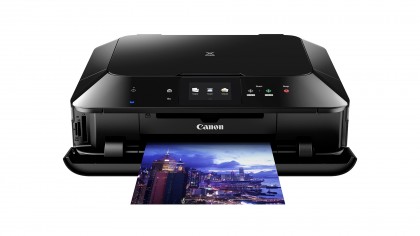Why you can trust TechRadar
The first prints that I made with the Canon MG7150 were of our printer test chart. This chart has a series of solid colour and gradation blocks as well as resolution lines and bars, this allows us to test a printer's ability to reproduce colour and detail in a more neutral way than normal prints would allow.
Generally you will find that there is a little difference between the transmissive on-screen image and the reflective print. Here with the MG7150, colours appear a little darker in the final print than on screen.
Generally speaking, the gradations on the single colour bars are very smooth, with little evidence of banding with two exceptions - the green and the cyan bars. Here we can see a line around half way across the bar.
For the multicoloured bars at the bottom of the chart, the gradation is a little smoother, with only the area between purple and blue on the bottom bar being a little more noticeable in its transition.
Looking at the resolution lines with the naked eye, the vertical and horizontal lines look close to perfect, while the diagonal ones appear a little more jagged. The concentric circles also look pretty close to perfect with the naked eye, although you can see a little stepping on the two innermost circles. The spaces between the lines appear to be pretty clean, too.

Putting the printer through real world testing reveals that prints of photographic images are a very good match for the on-screen picture. It's advisable to do a couple of test prints before printing a big batch to make sure that you're seeing what you want to see - and it's also worth running a screen calibration if you intend to get serious about your printing.
Colours are vibrant and details are generally well recorded. Prints made on glossy media look superb - we would always recommend using branded paper which matches the brand of the printer. In this case, we used Canon Photo Pus Glossy II for the majority of our prints. Skin tones are also rendered very accurately.
Sign up for breaking news, reviews, opinion, top tech deals, and more.
As the MG7150 has separate black inks, it doesn't need to mix colours to create monochrome prints. This results in neutral prints, with deep rich blacks. I wasn't able to find much evidence of detail being lost when blacks are too deep, but that may vary depending on the print you're making, and it's something that could be corrected for by calibrating the printer if you're intending to make a lot of black and white prints.

Printing times are swift. For small prints (6x4 and 7x5 inches), then times roughly match the quoted 14 seconds, or a little longer if you've switched to "Best" printing quality. For A4, borderless prints, on the automatic setting, a black and white image is printed in around 1 minute 10 seconds, while a black and white high quality print takes around 2 minutes 18 seconds. In terms of colour, a high quality A4 borderless prints, takes around 2 minutes 24 seconds. For standard, non-photo documents, printing takes a matter of seconds.
After installing a complete set of fresh cartridges (new from the box), we have been able to create in excess of 50 full-colour A4 prints before one cartridge (Magenta) is displaying a warning light that it is close to running out. The remaining cartridges have ink left in them, and if you like, when one cartridge runs out, you can override the warning that stops the printer making colour prints - this is handy if you're printing something which doesn't have one particular tone and want to take the risk.
While a complete set of six ink cartridges isn't exactly cheap at around £60-£70, we think this represents pretty good value. You can pick up third party inks for a fraction of the price, but we would always recommend using the matching brand inks for best image quality.
You can pick up a pack of 20 A4 photo sheets for around £10, while a pack of 7x5 or 7x4 paper can be picked up for around £5. We can therefore estimate that each A4 print costs somewhere between £1.20 and £1.40, depending on paper type. This isn't intended to be a wholly accurate price guide, since whatever you're printing can alter the paper and ink consumption, but it should give a rough idea. This compares pretty favourably with online printing services, while giving you the convenience of being able to print at home, with control over calibration settings.

Amy has been writing about cameras, photography and associated tech since 2009. Amy was once part of the photography testing team for Future Publishing working across TechRadar, Digital Camera, PhotoPlus, N Photo and Photography Week. For her photography, she has won awards and has been exhibited. She often partakes in unusual projects - including one intense year where she used a different camera every single day. Amy is currently the Features Editor at Amateur Photographer magazine, and in her increasingly little spare time works across a number of high-profile publications including Wired, Stuff, Digital Camera World, Expert Reviews, and just a little off-tangent, PetsRadar.
